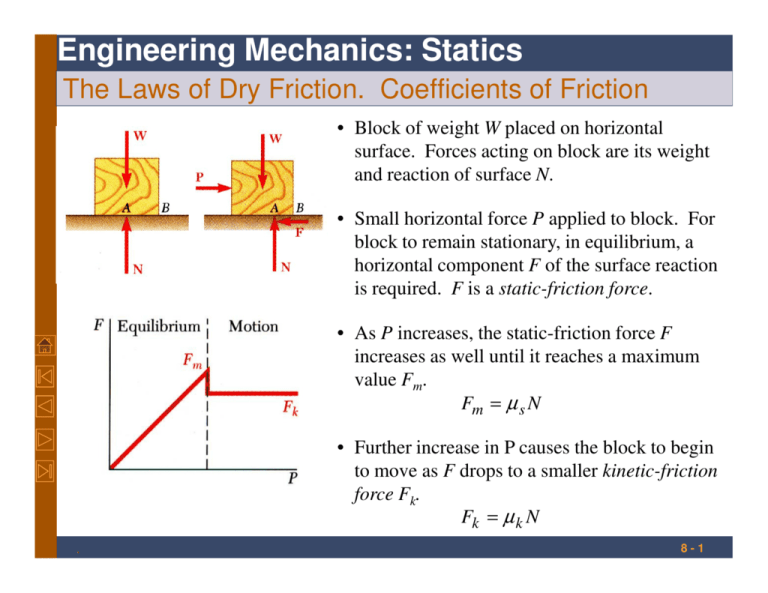Engineering Mechanics: Statics
advertisement

Engineering Mechanics: Statics The Laws of Dry Friction. Coefficients of Friction • Block of weight W placed on horizontal surface. Forces acting on block are its weight and reaction of surface N. • Small horizontal force P applied to block. For block to remain stationary, in equilibrium, a horizontal component F of the surface reaction is required. F is a static-friction force. • As P increases, the static-friction force F increases as well until it reaches a maximum value Fm. Fm = µ s N • Further increase in P causes the block to begin to move as F drops to a smaller kinetic-friction force Fk. Fk = µ k N . 8-1 Engineering Mechanics: Statics The Laws of Dry Friction. Coefficients of Friction • Four situations can occur when a rigid body is in contact with a horizontal surface: • No friction, (Px = 0) . • No motion, (Px < Fm) • Motion impending, (Px = Fm) • Motion, (Px > Fm) 8-2 Engineering Mechanics: Statics Angles of Friction • It is sometimes convenient to replace normal force N and friction force F by their resultant R: • No friction • No motion Fm µ s N tan φ s = = N N tan φ s = µ s . • Motion impending • Motion Fk µ k N tan φ k = = N N tan φ k = µ k 8-3 Engineering Mechanics: Statics Angles of Friction • Consider block of weight W resting on board with variable inclination angle θ. • No friction . • No motion • Motion impending • Motion 8-4 Engineering Mechanics: Statics Problems Involving Dry Friction • All applied forces known • All applied forces known • Coefficient of static friction is known • Motion is impending • Determine whether body will remain at rest or slide . • Coefficient of static friction is known • Motion is impending • Determine value of coefficient • Determine magnitude or of static friction. direction of one of the applied forces 8-5 Engineering Mechanics: Statics Sample Problem SOLUTION: • Determine values of friction force and normal reaction force from plane required to maintain equilibrium. • Calculate maximum friction force and compare with friction force required for equilibrium. If it is greater, block will not slide. A 100 lb force acts as shown on a 300 lb block placed on an inclined plane. The coefficients of friction between the block and plane are µs = 0.25 and µk = 0.20. Determine whether the block is in equilibrium and find the value of the friction force. . • If maximum friction force is less than friction force required for equilibrium, block will slide. Calculate kinetic-friction force. 8-6 Engineering Mechanics: Statics Sample Problem SOLUTION: • Determine values of friction force and normal reaction force from plane required to maintain equilibrium. ∑ Fx = 0 : 100 lb - 53 (300 lb ) − F = 0 F = −80 lb ∑ Fy = 0 : N - 54 (300 lb ) = 0 N = 240 lb • Calculate maximum friction force and compare with friction force required for equilibrium. If it is greater, block will not slide. Fm = µ s N Fm = 0.25(240 lb ) = 48 lb The block will slide down the plane. . 8-7 Engineering Mechanics: Statics Sample Problem • If maximum friction force is less than friction force required for equilibrium, block will slide. Calculate kinetic-friction force. Factual = Fk = µ k N = 0.20(240 lb ) Factual = 48 lb . 8-8





